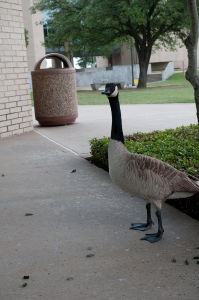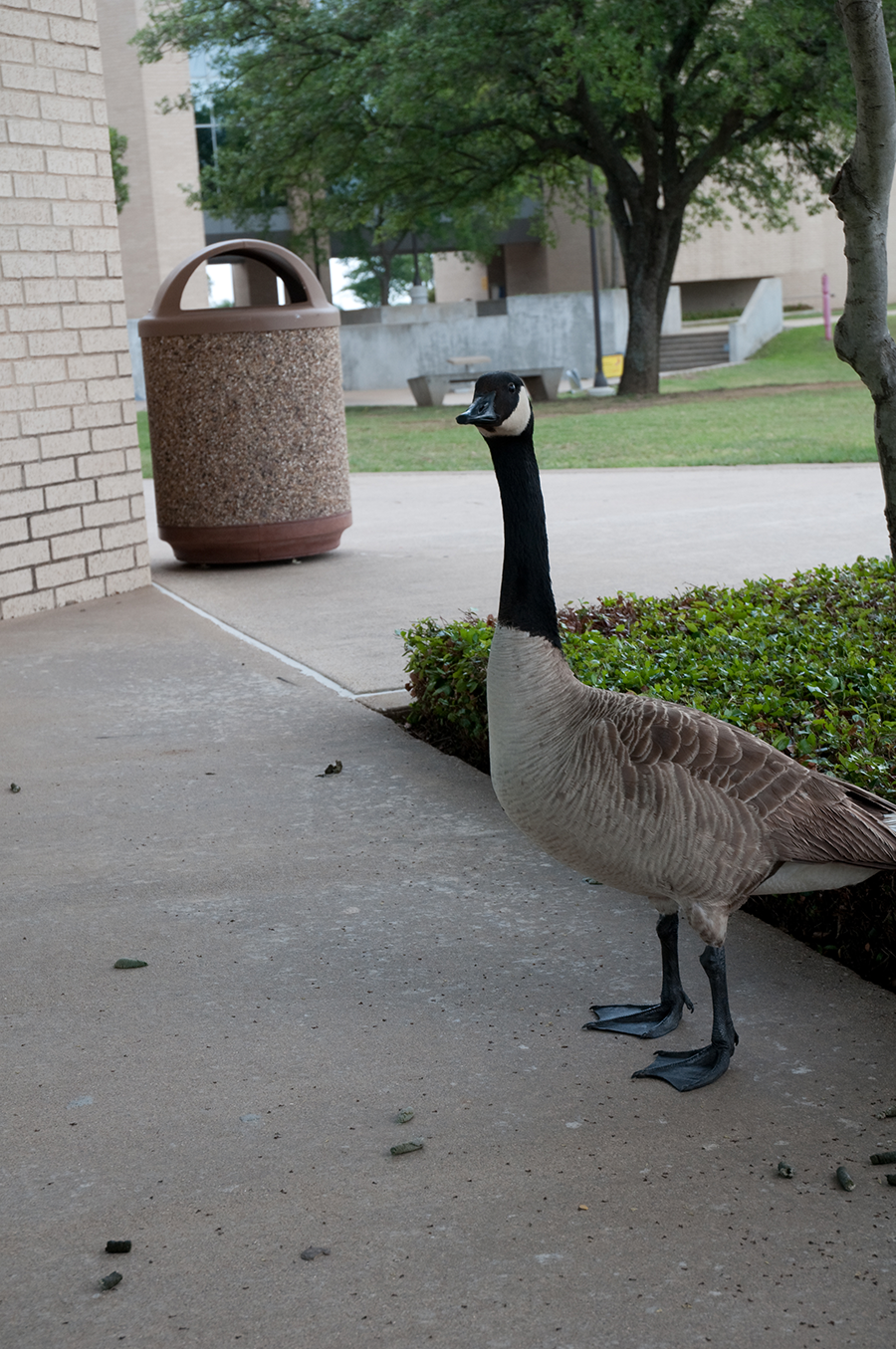By Bethany Peterson/nw news editor
Walking between WSTU and WACB, stopping to check out his appearance in the reflective glass, casting an eye toward the couple sitting on a bench, the only difference between him and the students is that … he’s a goose.

Martina Treviño/The Collegian
A Canadian goose, to be exact.
NW Campus groundskeepers first noticed him about three weeks ago. At first, he stayed near the lake but quickly started to venture up to the buildings closest to the lake.
According to canadageesenewjersey.com, there is no way to distinguish with certainty between a male and female Canadian goose without picking the goose up and checking. But no one has picked up this goose, and it roams alone, so it could be a “she,” but most refer to it as a “he.”
“He’s a trip,” said Michael Krieg, NW’s lead groundskeeper. “I think he really likes people.”
Kamron Johnson saw him for the first time a week ago.
“It just sat in one spot, and some lady came and took a picture,” Johnson said. “It got up and walked past me. It was funny.”
So funny that Johnson texted some friends, “So what do you do when you see a goose just standing in front of you?”
Replies included “quack at it,” “hug it or attempt to,” two suggestions to “kick it,” and finally, “If it’s big enough, try to sit on it.”
Thankfully, most students have been content with strange looks, snapshots and smiles.
There have been no reports of the goose approaching anyone deliberately. The day he was seen between WSTU and WACB, he stayed in the shady flower bed next to WSTU. Students passing within inches of him prompted no response.
Occasionally, he gets up and walks to the entry of WSTU. The glass-enclosed entryway seems to fascinate him, but whether he watches the people come and go or admires himself is up for debate.
Any time students are between him and where he wants to go, he just walks past them fearlessly. If students walk past him, he doesn’t move. He doesn’t mind the groundskeepers either.
“I was running a chainsaw one day, and he was right there,” Krieg said.
NW student Victoria Hamilton said she has seen the goose twice.
“I’ve never been around a goose before,” she said. “I was surprised he wasn’t attacking anyone. All I’ve ever heard about geese is that they are mean. But they [the victims] were probably doing something to get bit.”
But there have been few reports of anyone feeding the goose, and he seems happy to forage for himself.
“Canada Geese eat grain from fields, graze on grass and dabble in shallow water by tipping forward and extending their necks underwater,” according to allaboutbirds.org.
As a whole, Canadian geese spend most of their time in large flocks that include many relatives, the website said. They don’t usually mate until their fourth year and remain mated for life with “very low ‘divorce rates.’” So this goose being alone is rare.
But perhaps he isn’t alone. According to canadageese.org, the male may be guarding a hidden nesting female and only appear to be alone or he could have been injured and unable to join his flock. These explanations seem unlikely because of the NW goose’s non-aggressive behavior and healthy appearance.
The third explanation is he has lost a mate and is mourning before returning to a flock and perhaps selecting another mate.
Krieg had another explanation taking into account the goose’s comfort around people.
“People can buy them as little chicks,” he said.
He could have been someone’s pet and was either dumped in the lake when he was no longer wanted or he wandered away from home.
Whatever his past, NW Campus is a perfect home for a goose temporarily or permanently.
He has water, grassy fields that provide lots of food and an unobstructed view of any approaching predators.
Since he already has the acceptance of students and groundskeepers, predators might be this goose’s only problem.
“We do have coyotes in the area,” Krieg said. “I hope he doesn’t get eaten.”
The goose had no comment.

